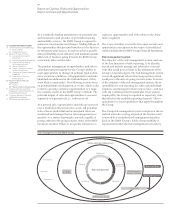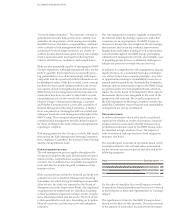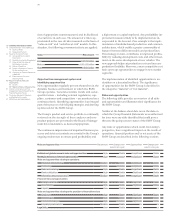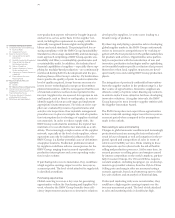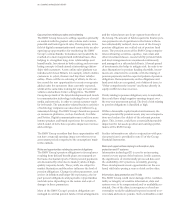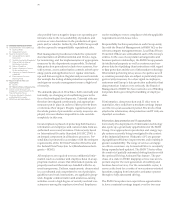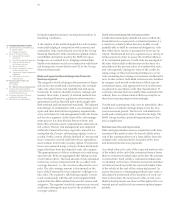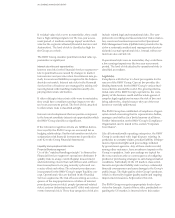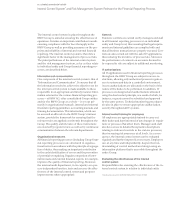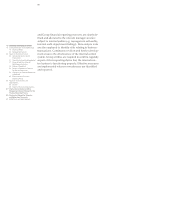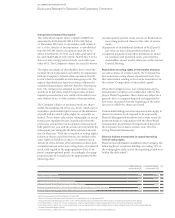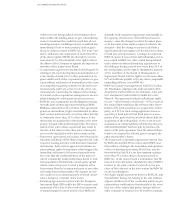BMW 2015 Annual Report Download - page 77
Download and view the complete annual report
Please find page 77 of the 2015 BMW annual report below. You can navigate through the pages in the report by either clicking on the pages listed below, or by using the keyword search tool below to find specific information within the annual report.77 COMBINED MANAGEMENT REPORT
assessment period compared to the assumptions made
in the outlook.
Financial risks and risks relating to the use of financial
instruments
Currency risks and opportunities
As an internationally operating enterprise, the BMW
Group conducts business in a variety of currencies, thus
giving rise to currency risks and opportunities. Since a
substantial portion of Group revenues is generated out-
side the eurozone (particularly in China and the USA)
and the procurement of production material and fund-
ing is also organised on a worldwide basis, fluctuations
in exchange rates can play a significant role for Group
earnings. Cash-flow-at-risk models and scenario analyses
are used to measure currency risks and opportunities.
Operational currency management is based on the results
provided by these tools. In 2015 the Chinese renminbi,
the US dollar, the British pound, the Russian rouble and
the Japanese yen constituted approximately 70 % of the
total foreign currency exposure of the BMW Group.
The BMW Group manages currency risks at both strate-
gic (medium and long term) and operating levels (short
and medium term). Medium- and long-term measures
include increasing production volumes in non-euro-
re-
gion countries (natural hedging) and increasing purchase
volumes denominated in foreign currencies. Construct-
ing new plants in countries such as the USA, China or
Brazil has also helped reduce foreign currency expo-
sures.
Currency risks are managed in the short to
me-
dium term and for operational purposes by means
of
hedging. Hedging transactions are entered into only with
financial partners of good credit standing. Opportunities
are also secured through the deployment of options.
Counterparty risk management procedures are carried
out continuously in order to monitor the creditworthi-
ness of business partners.
If currency risks were to materialise, they could have a
high earnings impact over the two-year assessment
period. A high level of risk is attached to currency risks.
Significant opportunities can arise if currency develop-
ments are favourable for the BMW Group.
Risks and opportunities relating to raw materials
Changes in prices of raw materials are monitored on the
basis of a set of well-defined management procedures.
The principal objective of these management processes
is to increase planning reliability for the BMW Group.
Price risks and opportunities relating to precious metals
(platinum, palladium, rhodium) and non-ferrous
metals
(aluminium, copper, lead) and, to some extent,
to steel and steel ingredients (iron ore, coke / coal) and
energy (gas, electricity) are hedged using financial
derivatives and / or supply contracts with fixed pricing
arrangements.
If risks relating to raw materials were to materialise,
they could have a medium earnings impact over the
two-year assessment period. A high level of risk is at-
tached to risks relating to raw materials.
Conversely, significant opportunities can arise if
prices of raw materials develop favourably for the
BMW
Group.
Liquidity risks
Based on experience gained during the financial crisis,
a minimum liquidity concept has been developed and is
rigorously adhered to. Solvency is assured at all times
throughout the BMW Group by maintaining a liquidity
reserve and by the broad diversification of refinancing
sources. The liquidity position is monitored continu-
ously at a separate entity level and managed by means
of a cash flow requirements and sourcing forecast system
in place throughout the Group. Liquidity risks may
be
reflected in rising refinancing costs. They may also
manifest themselves in restricted access to funds as a
consequence of the general market situation or the de-
fault of individual banks. The major part of the Finan-
cial Services segment’s credit financing and lease busi-
ness is refinanced on capital markets. Thanks to its
excellent creditworthiness, the BMW Group has good
access to financial markets and, as in previous years,
was able to raise funds at good conditions during the
year under report, reflecting a diversified refinancing
strategy and the solid liquidity and earnings base of the
BMW Group. Internationally recognised rating agencies
have additionally confirmed the BMW Group’s strong
creditworthiness.
If liquidity risks were to materialise, they could have a
low earnings impact over the two-year assessment
period. The risk of incurring liquidity risk is classified
as low – including the risk of the BMW Group’s rating



